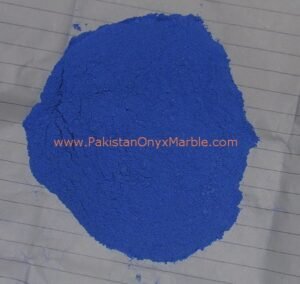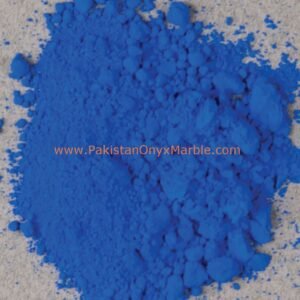Lapis Lazuli Pigment
Lapis Lazuli pigment refers to a blue-colored pigment derived from lapis lazuli gemstone. Lapis lazuli has been used as a pigment for centuries, dating back to ancient times, and it was highly valued for its intense and vibrant blue hue.
Here are some key points about Lapis Lazuli pigment:
Color and Richness: Lapis Lazuli pigment is known for its deep and intense blue color. It is often described as a “ultramarine blue” shade, and it has a rich and captivating appearance.
Historical Significance: Lapis Lazuli pigment has a long history of use in art and decoration. It was a prized pigment during the Renaissance and Baroque periods, and it was used by renowned artists in their masterpieces.
Ground Lapis Lazuli: To obtain Lapis Lazuli pigment, the gemstone is ground into a fine powder. This powder is then mixed with a binding medium, such as oil or water, to create paint or ink for artistic and decorative purposes.
Luxury and Rarity: Historically, Lapis Lazuli pigment was rare and expensive due to the scarcity and difficulty of obtaining high-quality lapis lazuli gemstone. It was often reserved for prestigious commissions and high-end artworks.
Modern Usage: While Lapis Lazuli pigment is still used by some artists and conservators today, its popularity has decreased over time due to the availability of synthetic pigments that can mimic its color at a more affordable price.
Art Conservation: Lapis Lazuli pigment is also valued in art conservation efforts to restore and preserve historical artworks that originally used this precious pigment.
It’s essential to note that Lapis Lazuli pigment is not commonly found in mass-produced art supplies, and its use in modern artworks is often limited to traditional or historical artistic techniques. If you come across artwork labeled as “Lapis Lazuli pigment,” it may indicate that the artist is employing traditional methods or following historical practices.
For those interested in using Lapis Lazuli pigment for art purposes or in art restoration, it’s best to seek out specialty art supply stores, conservators, or experts familiar with traditional pigments and historical techniques. Additionally, due to the rarity and value of genuine Lapis Lazuli pigment, it’s crucial to ensure the authenticity and quality of the product when purchasing or using it in artistic endeavors.
Physical Properties of Lapis Lazuli
Classification A metamorphic rock that contains enough of the mineral lazurite to impart a distinct blue color. It may also contain significant amounts of calcite, pyrite, and minor amounts of other minerals.
Color Blue. Often with white calcite veining or mottling, and gold grains of pyrite.
Streak Blue.
Luster Dull, but polishes to a bright luster.
Diaphaneity Semi-translucent to opaque.
Cleavage None, though it may split easily along foliation or calcite veins and layers.
Mohs Hardness Varies between the 3 of calcite and the 5 to 5.5 of lazurite. Not well suited for use as a ring stone or in bracelets.
Specific Gravity 2.7 to 2.9 or more depending upon the amount of pyrite
Diagnostic Properties Blue color, association with pyrite, and hardness.
Uses Cabochons, beads, carvings, spheres, inlay, and pigments.
























